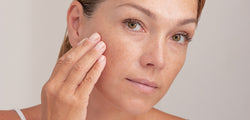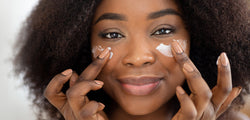
Melasma vs Hyperpigmentation: What’s the Difference?
Table of Contents:
What's the difference between melasma vs hyperpigmentation? Truth be told, very few if any people can answer this question confidently, comprehensively or without stuttering. Nevertheless, understanding the difference between hyperpigmentation and melasma is actually key to unlocking the potential of your skin's flawlessness. And as much as the two share a lot of dermatological symptoms or presets, they are vastly different in the long term scheme of things. Here's a quick primer of the difference between melasma and pigmentation.
The Main Difference Between Melasma and Hyperpigmentation
To illustrate the striking contrast between dermal hyperpigmentation and conventional melasma, it is imperative to first-of-all diffuse hyperpigmentation by defining it from first principles. Remember that both of these are extremely common types of blemishes and are a result of almost similar dermatological conditions. Here, we will take a closer look at the differences and similarities of hyperpigmentation vs melasma with a special emphasis on how to prevent the two or banish them should you be unfortunate enough to fall victim to either of the two.
Understanding Hyperpigmentation
Hyperpigmentation is simply an umbrella term that is used to describe a number of skin conditions where a skin patch becomes noticeably and significantly darker than the immediate surrounding skin in the same neighbourhood. The term covers a good number of specific dermatological conditions such as freckles, melasma and liver spots.

Having said that, as much as different types of hyperpigmentation are caused by varying factors such as medications, acne scarring and inflammation originating from miscellaneous factors, the chief culprit in 85% of cases of hyperpigmentation is unprotected sun exposure. Here's the thing; leaving the skin unshielded leaves it susceptible to damage by injurious UV rays from the sun. Depending on the severity of exposure, this damage will manifest itself in various ways, ranging from mere freckles to more serious health conditions in the league of skin cancer.
Many types of hyperpigmentations, nonetheless, are virtually harmless and usually don't result in lingering complications other than minor cosmetic effects. Either way, they are typically readily treatable via an array of cosmetic options such as vitamin C serums, topical treatments and skin lightening creams. Actually, with a majority of hyperpigmentation forms, the patient only needs to worry about the blunt that their physical appearance takes rather than possible long-lasting complications. Nevertheless, it is still mightily important to get checked out by a qualified dermatologist just to rule out any possibilities of underlying damage.
What About Melasma?
Melasma is, in its most basic form, a type of hyperpigmentation that affects more than 5 million Americans at any given point. It is also characterized by darkened skin patches and discolourations that are quite noticeable and cannot be mistaken for anything else. Melasma, however, differs from other types of hyperpigmentation by its apparent cause. Instead of being just sun-related or a mere sunburn, melasma is partly caused by specific hormonal changes that occur in the body.
It is for this reason, therefore, that melasma is colloquially referred to as a 'pregnancy mask'. Pregnant women, more than other subsets of the population, are more likely to show symptoms of this condition. If anything, melasma is very common among women (significantly more than men) simply because of this hormonal connection.
Interestingly, melasma is christened 'mask' due to its tendency to target one's face in comparison to other parts of the body. That's the reason it is characterised by darkened and hyperpigmented skin patches on the cheeks, chin, upper lip and nose. Skin experts believe that this phenomenon is fueled by the fact that these areas tend to be more prone to sun exposure than others. And this makes a lot of sense when you take into account that melasma is also notably more common in other more frequently exposed parts of the body such as the shoulders and lower arms.
As much as melasma is not generally considered dangerous, these unsightly darkened patches can do a number to one's self-esteem and image to the point of being self-conscious in public.
Hyperpigmentation vs Hypopigmentation: Debunking the Myths
The differences between hyperpigmentation vs hypopigmentation start right from the terminology. Hyperpigmentation, as you would have guessed, refers to an increase in the amount of melanin in your pigmentation. Hypopigmentation, on the other side of the divide, implies having less melanin than usual.

Thus, while hyperpigmentation usually manifests itself as a dark spot as a direct result of excess melanin on a particular part of the body, hypopigmentation is characterized by abnormally pale skin almost to the point of albinism. Incidentally, other skin conditions such as vitiligo and inflammatory fungal infections that present themselves as pale patches also fall under this bracket.
In the debate between hypopigmentation vs hyperpigmentation, one of the pointers that most people tend to overlook is that the two vastly different conditions share similar causes. And these include;
- Pregnancy and other hormonal fluctuations - This includes birth control or medications that trigger hormonal swings
- Age - You are more likely to suffer from any of the two conditions the older that you get. In such cases, they are dermatologically referred to as liver or age spots.
- Solar exposure - In some people more than others, excessive sun exposure often culminates in hyperpigmentation or hypopigmentation.
- Trauma, injury or acne - The resultant pigmentation in such cases is known as post-inflammatory hypopigmentation or post-inflammatory hyperpigmentation.
Melasma vs Sunspots: What are the Differences Between the Two
Now that you know the contrasts and similarities between hypopigmentation and hyperpigmentation, it is only natural to wonder where the limits between hyperpigmentation vs sunspots start and end.
Visually speaking, it is almost impossible to tell the difference between melasma vs sunspots without carrying out a battery of tests. Both of them (as expected) are types of hyperpigmentation, but that's where the similarities end. Melasma, unlike sunspots, is partly caused by fluctuations in the body's hormonal composition. And this explains why it tends to be more common among women (especially expectant and those taking birth control) than in men.
Speaking of which, people with oily skin types are also somewhat more susceptible to melasma hyperpigmentation than those with dry skin profiles. Experts think that this unusual correlation stems from the fact that pigmentation cells in people with oily skin are typically over-active and easily aggravated than in other people. This, therefore, implies that they will naturally produce more pigment than their counterparts with dry or normal skin in the event of a melasma-inducing phenomenon.
So which is easier to treat, melasma or sunspots? Well, for starters, a person's hormonal profile has a larger role to play in the darkening and development of melasma than in sunspots. Thus, in this type of hyperpigmentation vs sunspots tug of war, sunspots are remarkably easier to deal with than melasma.
Besides, melasma presents itself differently compared to other forms or types of hyperpigmentation. Dermatologists, for instance, are able to distinguish it from other types of blemishes using a special VISIA camera system that uses UV photography technology to show the damage that reaches the deeper levels of the skin. What's more, unlike pure sunspots which can assume any haphazard shape, melasma often presents in a characteristic fashion resembling islands of pigmentation. Intrinsically, melasma manifests in significantly bigger pigmented patches rather than isolated spots as it is in the case of sun damage.
Melasma vs Age Spots
Age spots are a form of hyperpigmentation that mostly occurs in people above 50 years. In the melasma vs age spots argument, it is correct to lump together both of these under the hyperpigmentation bracket, especially considering that all of them are a result of increased melanin production. The only difference is that the term 'age spots' is more or less a direct reference to one's chronological or biological dotage.

That said, another notable contrast between age spots vs melasma is that the former is largely a result of melanin production following years of solar overexposure. Such a form of hyperpigmentation is more likely to occur in people with fair skin than those with a darker skin tone.
As the name suggests, age spots typically look like minuscule spots and not large patches as in the case of melasma. They can appear alone or in a cluster depending on the severity of sun exposure in your younger years. They are also unlikely to be evenly symmetrical, another prominent feature of melasma.
Treating Hyperpigmentation and Hypopigmentation
Fortunately, as much as hyperpigmentation is very common nowadays, there exists several proven and quite effective ways of dealing with darker patches that appear unannounced thereby ruining your complexion. Here is a selection of the class of the field.
1. Skin Lightening and Brightening Creams
One of the best ways of combating hyperpigmentation is through the correct and consistent use of skin lightening creams. These over the counter (OTC) treatments typically work by infusing select ingredients to the underlying layers of your skin in an effort to decrease the rate of pigmentation.

Speaking of which, a good example of such a highly-rated cream is Maryann's Dark Spot Corrector Cream. The cream employs 100% natural ingredients to correct hyperpigmentation without risking any serious side effects as is often the case with standard bleaching agents. With such a topical and noninvasive topical treatment, all you have to do is rub on the cream generously to the affected areas once or twice a day and watch the darkened patches disappear slowly over time. What's even better, the cream is also formulated to prevent the onset of future pigmentation from acne breakouts or scars.
2. Face Acids and Exfoliators
Skin acids, also known as face acids, work by shedding and exfoliating the top-most layer of the skin to reveal fresh, undamaged and, most importantly, unpigmented skin cells. You see, whenever you exfoliate and scrub off dead skin from your face, newer cells emerge in their place. Apart from getting rid of the badly-melanated patches physically, sloughing off dead cells smoothes out your skin tone making it more evenly attractive in the long run.
One of the best skin exfoliation machinery in the business is Maryann's 30% Glycolic Acid Pads. As the product name implies, it taps into the power of an Alpha Hydroxy Acid to diffuse hyperpigmentation by loosening the bonds between the dead skin cells making it incredibly easy to excavate them from your face. The results are nothing short of fantastic.
3. Retinoids
A derivative of vitamin A, retinoids are arguably one of the oldest and most popular skincare ingredients known to man. Their minuscule molecular structures make them the best-suited additive to penetrate deep into your skin to combat and diffuse hyperpigmentation from a cellular level. And although the OTC versions of retinoids are a bit less potent than prescription retinol-containing creams, there exist decent ones like Maryann's Retinol Cream that are perfectly suited for dealing with mild cases of melasma when used consistently.
In Closing - The Takeaway
As you can see, there is no shortage of treatment options even for the worst cases of hyperpigmentation and melasma. There's no excuse to wallow in self-pity or throwing in the towel just because a few age spots or melanated patches are ruining your complexion. It's entirely possible to reclaim your youthful flawlessness given the right level of discipline and commitment to taking care of your skin.













